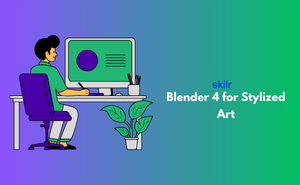👇 CELEBRATE CLOUD SECURITY DAY 👇
00
HOURS
00
MINUTES
00
SECONDS

Blender 4 for Stylized Art
Industry-endorsed certificates to strengthen your career profile.
Start learning immediately with digital materials, no delays.
Practice until you’re fully confident, at no additional charge.
Study anytime, anywhere, on laptop, tablet, or smartphone.
Courses and practice exams developed by qualified professionals.
Support available round the clock whenever you need help.
Easy-to-follow content with practice exams and assessments.
Join a global community of professionals advancing their skills.
To improve your Blender skills for stylized art, it’s essential to practice regularly and take on various projects. Participate in online communities, attend workshops, and seek feedback from experienced artists to improve your craft. Stay up to date with Blender’s new features and tools, such as the introduction of new procedural modeling techniques and rendering improvements. Networking with other artists and maintaining a portfolio of your stylized 3D work is also crucial to staying competitive in the job market.
Stylized art trends in 3D modeling are evolving with the rise of cel-shaded designs, low-poly art, and hand-painted textures. In gaming, there is a growing demand for whimsical and fantastical environments, characters with exaggerated proportions, and bright color schemes. Trends in animation emphasize stylized 3D assets that are visually unique and convey strong artistic expression. Keeping an eye on these trends and integrating them into your portfolio can help you stay relevant in the growing market for stylized 3D art.
Industries that frequently hire Blender artists skilled in stylized art include gaming, animation, film production, virtual reality (VR), augmented reality (AR), and digital media. Within gaming, stylized art is particularly popular for mobile and indie games, as well as for characters and assets in animated series. The entertainment industry also seeks stylized artists for animation studios and visual effects (VFX) companies. Additionally, architectural visualization and product design are beginning to adopt stylized techniques for more engaging presentations.
Yes, texturing is a crucial skill for creating stylized 3D art. Stylized textures, such as hand-painted or simplified surface details, contribute to the overall aesthetic of the artwork. Blender’s powerful texture painting and procedural material creation tools allow artists to design unique and stylized textures that suit their visual style. Mastering texturing techniques in Blender enables artists to bring their 3D models to life in a way that aligns with the intended artistic direction.
Yes, Blender is highly versatile and can be used for both stylized and realistic 3D art. While stylized art focuses on exaggeration and artistic abstraction, realistic art requires a more grounded approach, including highly detailed textures, lighting, and shaders. Blender’s tools, such as sculpting, shading nodes, and advanced rendering techniques (Cycles and Eevee), allow artists to choose the appropriate workflow based on the style they wish to create.
The demand for stylized 3D art is growing, especially in game development, animation, virtual reality, and digital media. Stylized art is sought after for mobile games, indie games, animated films, and interactive media. Blender’s affordability and powerful feature set provide an accessible tool for independent artists and small studios to meet these market needs. With the increased demand for unique, visually engaging content, Blender’s tools enable artists to create stylized assets efficiently.
This course is ideal for aspiring 3D artists, game developers, animation artists, and designers. Whether you are a beginner looking to get started with Blender or an experienced artist wanting to refine your skills in stylized art, this course offers practical, hands-on learning. Professionals working in game development, animation, architectural visualization, and digital art will find this course especially useful to create visually stunning stylized 3D assets.
Blender artists skilled in stylized art have a wide range of career opportunities. Jobs include roles like 3D Modeler, Texture Artist, Environment Artist, Character Artist, and Asset Designer. Many companies in the gaming, animation, and entertainment industries seek artists proficient in stylized 3D modeling to create unique characters, environments, and props. Freelancers and contractors also find ample opportunities to work on stylized projects across various industries.
To get started with Blender 4 for Stylized Art, you'll need a strong understanding of 3D modeling fundamentals, texturing, and lighting techniques. Skills in using Blender’s user interface, modeling tools, and basic rendering with Eevee or Cycles are essential. Additionally, understanding sculpting, material creation, and using modifiers such as Subdivision Surface and Geometry Nodes will significantly enhance your workflow for stylized designs.
Blender 4 stands out due to its open-source nature, accessibility, and frequent updates, making it a strong contender compared to other 3D software. Blender’s node-based workflow, sculpting tools, and robust material and texture editor make it a versatile choice for creating stylized art. With features like the Geometry Nodes system, stylized asset creation has become more intuitive and customizable compared to other proprietary software like Maya or 3ds Max.